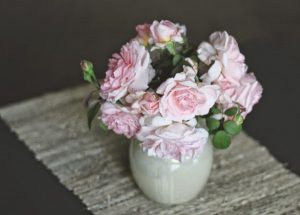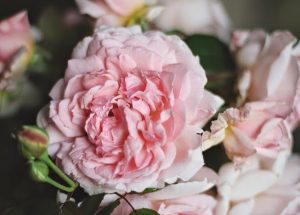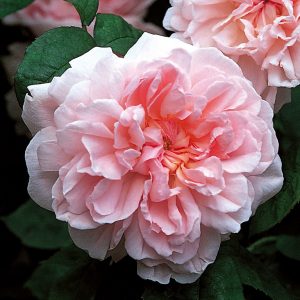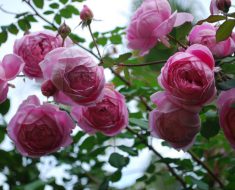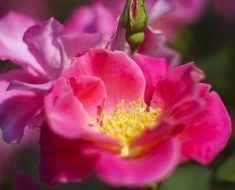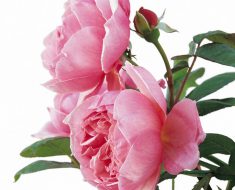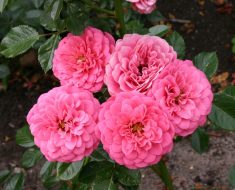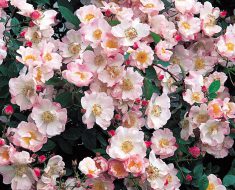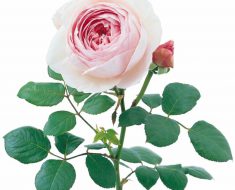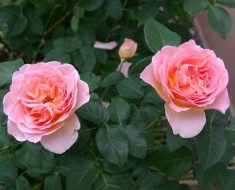English rose Eglantine is named after Eglaineine Jeb, founder of the Save the Children Foundation.
Group – English roses
Subgroup – English hybrids of Old roses
Aroma – strong
Shape – bush
Color – light pink
Type of flowering – repetitive
Height – 1,2 m
Distribution – 0,9 m
Resistance to powdery mildew – medium
Resistance to black spot – medium
Winter hardiness – medium
Selector – D. Austin
Catalog name – AUSMAK
Year of introduction to culture – 1994
Eglantine is one of the most beautiful English roses. Her flowers in the style of Old roses blossom out of pointed ovoid rounded dense buds. The average diameter of the flower is 7-8 cm. The flower can have from 41 to 140 petals of tender light pink color. They are assembled chaotically in a rosette. Flowers bloom in small clusters (3-9 flowers) and blossom one by one. Long hold. During the drought, the rose quickly fades. Over time, the color of the flower “burns out” to milky pink. In the fully opened state, a dark yellow mid-button is shown from the stamens. Flowering – abundant, phase and begins with late spring (in warm regions) and lasts until frost.
The bush of the Eglantine rose is branched: flowering flexible offshoots form on the main skeletal branches. Prickly. Foliage – matte, yellowish-green, leathery, prone to black spotting and powdery mildew. The rose has a strong aroma in the style of Old roses with notes of oriental spices. Also, it tends to grow to larger sizes (2 m and more) and can be grown as a short climber.
Care
The soil. To plant the English rose Eglantine fit almost any loose soil. Their pH should not exceed the limits from 5.5 to 6.5. Water and air permeability of the ground will provide a simple and quick access to moisture and nutrients. Therefore, it is very important to arrange a good drainage and “dilute” with sand and compost if the place where your rose grows, the soil is hammered and heavy. The planting pit should be 1.5-2 times larger than the root system of the flower.
Watering – is the introduction of fluid into the base of the bush for the normal life of the plant. Roses are watered when the top layer of the soil dries 3-5 cm deep. For a rose bush Eglantine will need from 10 liters of warm water. As a rule, watering is carried out 1-2 times a week, depending on the weather conditions. In arid time, if necessary, watered every day. At such an hour, spraying in the evening will be useful.
Feeding is needed for the plant to stay healthy and beautiful. Give a rose “goodies” 1 time in 2 weeks. You can use both liquid and solid fertilizers. The first fertilizer will get a flower faster, and the second will come in small doses, but for a longer time. When entering, you must remember that you need to feed as you water it, over the entire area of the root system. In addition, there are fertilizers that are better used by the plant through its aerial part. Basically, it’s microelements and vitamins. They are introduced by spraying.
The first time Eglantine’s rose is fed immediately after the opening from winter shelter. For this, it is better to take solid fertilizers. In addition, their main component should be nitric. Such additional fertilization stimulates the growth of the green mass of the plant. In the future, in top dressing it is necessary to reduce the dose of nitrogen, and increase the content of potassium and phosphorus, stimulating the formation of flowering buds and strengthening the health of the flower. That the rose was strong and less exposed to diseases, we recommend to feed a grade of roses Eglantine 1 time in one and a half weeks.
For a neat and healthy species, each lignified plant needs pruning. It is done in spring, and in summer and in autumn. removed old, sick and damaged over the winter parts from rose. You can leaves 7-9 main branches, shortening them by one third. In summer, faded flowers are constantly cut, so that the rose remains constantly blooming. In autumn, the trimming purpose is to prepare the plant for wintering. In cold regions, only a third of the branch is left above the ground.
Eglantine is a rose that requires mandatory shelter for the winter. Preliminary cleaning and hilling, as well as preventive treatment with anti-disease preparations of the bush and soil around. By the way, disease prevention for her should be carried out throughout the growing season to avoid the appearance of diseases to which the rose is prone.
And finally, loosening and weed removal, helping the plant to obtain useful substances, water and area in the right quantities, eliminating annoying weeds. We need to grit and loosen gently, so as not to damage the tender roots. To reduce the number of harmful plants and to retain moisture in the soil, mulch can be applied by pouring it in a layer of 3-5 cm. For this purpose, well-used manure, the bark of non-sour trees, dry grass without seeds, agrobel or other mulching agents that do not tolerate diseases, not acidifying the soil, in general, not harmful to the plant.
Using
Like most English roses, Eglantine’s rose is suitable for growing in any flower-wood composition. It can also be grown in containers. A gentle pink color will harmonize with almost all plants. The best plantings for her will be curbs, hedges and mixborders. The style of the garden will acquire a kind of gentle romanticism, where the English roses of the Eglantine variety will grow.
